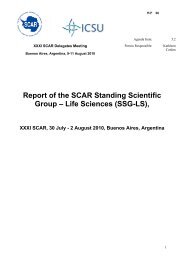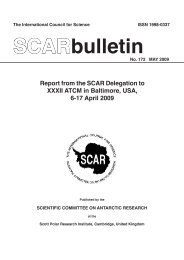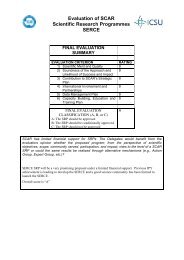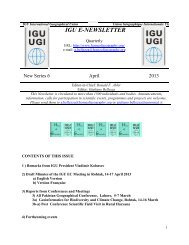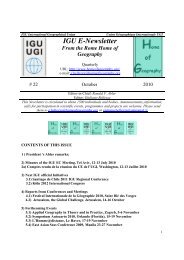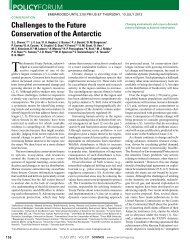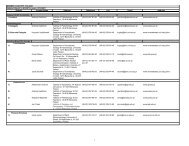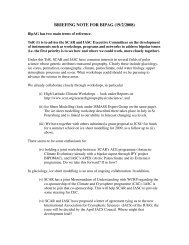SCAR Strategic Plan - Scientific Committee on Antarctic Research
SCAR Strategic Plan - Scientific Committee on Antarctic Research
SCAR Strategic Plan - Scientific Committee on Antarctic Research
You also want an ePaper? Increase the reach of your titles
YUMPU automatically turns print PDFs into web optimized ePapers that Google loves.
<str<strong>on</strong>g>SCAR</str<strong>on</strong>g> STRATEGIC PLAN 2004–2010<br />
of ice sheet variability over the last few hundred thousand<br />
years, which could critically advance our understanding<br />
of ice sheet stability.<br />
Much still remains to be learned about the geological<br />
history of <strong>Antarctic</strong>a. There is a need to focus geological<br />
attenti<strong>on</strong> <strong>on</strong> particular areas that are still largely unknown,<br />
like the subglacial highlands of the Gamburtsev Mountains<br />
hidden beneath the East <strong>Antarctic</strong> Ice Sheet. There is no<br />
c<strong>on</strong>tinent <strong>on</strong> Earth other than <strong>Antarctic</strong>a that has a huge<br />
central mountain range for which an explanati<strong>on</strong> in terms<br />
of plate tect<strong>on</strong>ics does not exist. How did these features<br />
come to be there, and how did they influence the growth<br />
of the ice sheet?<br />
Studies like these are essential to understand the history<br />
of moti<strong>on</strong> of the Earthʼs lithospheric plates, and the tect<strong>on</strong>ic<br />
processes taking place in and around <strong>Antarctic</strong>a, which are<br />
integral to our understanding of whole Earth evoluti<strong>on</strong>.<br />
In much the same way, geophysical observatories <strong>on</strong><br />
<strong>Antarctic</strong>a, such as those engaged in earthquake locati<strong>on</strong>,<br />
are integral parts of a global network of stati<strong>on</strong>s recording<br />
Earth properities. That network must be as complete as<br />
possible to provide maximum benefit.<br />
Studies of the <strong>Antarctic</strong> atmosphere are essential for<br />
the forecasting of weather c<strong>on</strong>diti<strong>on</strong>s, and to understand<br />
the chemical processes taking place high in the stratosphere<br />
above <strong>Antarctic</strong>a that result in the oz<strong>on</strong>e hole, creating<br />
c<strong>on</strong>diti<strong>on</strong>s potentially harmful to life in those same areas,<br />
and depleting stratospheric oz<strong>on</strong>e levels globally.<br />
<strong>Antarctic</strong>a is <strong>on</strong>e of the best places to study “geospace”<br />
the regi<strong>on</strong> where the Earthʼs atmosphere interacts with the<br />
solar wind, a supers<strong>on</strong>ic stream of charged particles emitted<br />
from the sunʼs cor<strong>on</strong>a. Electr<strong>on</strong>s and i<strong>on</strong>s in the solar wind<br />
collide with atoms and molecules in the upper atmosphere,<br />
causing them to emit phot<strong>on</strong>s, forming the aurora australis<br />
and heating the upper atmosphere. The interacti<strong>on</strong> of the<br />
solar wind with the Earthʼs magnetic field also creates<br />
a wide range of other effects including geomagnetic<br />
storms, disrupti<strong>on</strong>s in short-wave radio communicati<strong>on</strong>s,<br />
and power surges in l<strong>on</strong>g electricity transmissi<strong>on</strong> lines.<br />
Important gaps remain in our understanding of the<br />
interacti<strong>on</strong> of the solar wind with the Earthʼs protective<br />
outer layers – the magnetosphere and the i<strong>on</strong>osphere -<br />
especially under extreme solar wind c<strong>on</strong>diti<strong>on</strong>s associated<br />
with geomagnetic storms and with mass ejecti<strong>on</strong>s from<br />
the sunʼs cor<strong>on</strong>a. Full understanding of the physics of<br />
“geospace” requires coordinated observati<strong>on</strong>s in both the<br />
Arctic and the <strong>Antarctic</strong>.<br />
<strong>Antarctic</strong>a is also <strong>on</strong>e of the best places in the world<br />
from which to study the cosmos, because the skies above<br />
the <strong>Antarctic</strong> plateau are the coldest, driest and most stable<br />
<strong>on</strong> the Earth. This permits observati<strong>on</strong>s of extraordinary<br />
sensitivity to be made across the electromagnetic spectrum<br />
from the near ultra-violet to the millimetre wavebands.<br />
The combinati<strong>on</strong> of great sensitivity and clarity of<br />
visi<strong>on</strong> makes <strong>Antarctic</strong> observatories str<strong>on</strong>g candidates<br />
for exploring <strong>on</strong>e of the most challenging and exciting<br />
fr<strong>on</strong>tiers in science, the detecti<strong>on</strong> of Earth-like planets<br />
in the Galaxy. In additi<strong>on</strong>, c<strong>on</strong>diti<strong>on</strong>s are favourable for<br />
the c<strong>on</strong>structi<strong>on</strong> of telescopes capable of detecting the<br />
neutrino emissi<strong>on</strong> from individual astrophysical objects.<br />
<strong>Antarctic</strong>a is a prime locati<strong>on</strong> for the observati<strong>on</strong> of cosmic<br />
rays, because proximity to the magnetic pole allows rays<br />
of lower energy to penetrate to the ground more readily<br />
than at mid-latitude locati<strong>on</strong>s.<br />
3.2 The <str<strong>on</strong>g>SCAR</str<strong>on</strong>g> <str<strong>on</strong>g>Scientific</str<strong>on</strong>g> Programmes<br />
Based <strong>on</strong> the above analysis, <str<strong>on</strong>g>SCAR</str<strong>on</strong>g> has decided to<br />
focus its efforts <strong>on</strong> a limited number of major <str<strong>on</strong>g>Scientific</str<strong>on</strong>g><br />
<strong>Research</strong> Programmes (SRPs) addressing significant<br />
topical issues.<br />
To facilitate development of these programmes, and<br />
to manage its portfolio of science more effectively, <str<strong>on</strong>g>SCAR</str<strong>on</strong>g><br />
created in 2002 a new science management structure<br />
(Annex 4). Centred <strong>on</strong> three Standing <str<strong>on</strong>g>Scientific</str<strong>on</strong>g> Groups<br />
(SSGs) <strong>on</strong> Geosciences, Life Sciences, and Physical<br />
Sciences, this structure is intended to ensure appropriate<br />
cross-disciplinary awareness and linkages inside and<br />
outside the organizati<strong>on</strong>. <str<strong>on</strong>g>SCAR</str<strong>on</strong>g> looks to the SSGs to<br />
identify the major scientific challenges of the time.<br />
A <str<strong>on</strong>g>Scientific</str<strong>on</strong>g> Programme <str<strong>on</strong>g>Plan</str<strong>on</strong>g>ning Group will<br />
develop a plan for each SRP. Guidelines for Programme<br />
development are given in the <str<strong>on</strong>g>SCAR</str<strong>on</strong>g> Rules of Procedure<br />
for Subsidiary Bodies <strong>on</strong> the <str<strong>on</strong>g>SCAR</str<strong>on</strong>g> web site (http://www.<br />
scar.org). The SRPs are intended, to the extent possible, to<br />
be interdisciplinary; to interact with other <str<strong>on</strong>g>SCAR</str<strong>on</strong>g> research<br />
activities; and to have a lifetime of 5-10 years. They<br />
should make significant advances in our understanding of<br />
how the <strong>Antarctic</strong> regi<strong>on</strong> works, and its role in the global<br />
system. <str<strong>on</strong>g>SCAR</str<strong>on</strong>g> provides SRPs with seed-corn funds to<br />
facilitate meetings and workshops needed to develop the<br />
Programmes.<br />
<str<strong>on</strong>g>Plan</str<strong>on</strong>g>s for the first set of five programmes were<br />
approved by the <str<strong>on</strong>g>SCAR</str<strong>on</strong>g> Nati<strong>on</strong>al Delegates at their meeting<br />
in October 2004. Others will be developed as time goes<br />
by. The five approved <str<strong>on</strong>g>Scientific</str<strong>on</strong>g> <strong>Research</strong> Programmes<br />
(downloadable from the <str<strong>on</strong>g>SCAR</str<strong>on</strong>g> web page) are:<br />
• Subglacial Lake Explorati<strong>on</strong> (SALE)<br />
• <strong>Antarctic</strong>a and the Global Climate System<br />
(AGCS)<br />
• <strong>Antarctic</strong> Climate Evoluti<strong>on</strong> (ACE)<br />
• Evoluti<strong>on</strong> and Biodiversity in the <strong>Antarctic</strong> (EBA)<br />
• Inter-hemispheric C<strong>on</strong>jugacy Effects in Solar-<br />
Terrestrial and Aer<strong>on</strong>omy <strong>Research</strong> (ICESTAR)<br />
For each of these Programmes a brief outline is<br />
given in Annex 5 of the purpose, scope and overall<br />
objectives. In each case, the scientific objectives will be<br />
addressed through a series of projects that together form<br />
a comprehensive research programme. Each research<br />
project will be defined by its own scientific objectives and<br />
requirements for logistics and technology. The timing of<br />
individual projects will ultimately be determined by the<br />
resources and technologies available and the priorities<br />
of the individual nati<strong>on</strong>al <strong>Antarctic</strong> programmes through<br />
which funding is made available. The projects may not<br />
9



